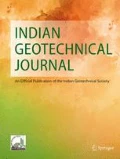Abstract
This study examines the potential of multi-gene genetic programming (MGGP) based classification approach to evaluate liquefaction potential of soil in terms liquefaction index (LI) using a large database from post liquefaction cone penetration test (CPT) measurements and field manifestations. The database consists of CPT measurements; cone tip resistance (q c ), friction ratio (R f ), vertical total stress (σ v ) and vertical effective stress of soil (σ ′ v ), seismic parameters; peak horizontal ground surface acceleration (a max ) and earthquake moment magnitude (M w), and the depth under consideration (z). The MGGP models (Model-I and Model-II) are developed for predicting occurrence and non-occurrence of liquefaction on basis of combination of above input parameters. The performance of the Model-I (95 %) is found to be more efficient compared to available artificial neural network model (91 %) and that of the Model-II (97 %) is found to be at par with the available support vector machine model (97 %) in terms of rate of successful prediction of liquefied and non-liquefied cases for testing data. Using an independent database of 96 cases, the overall classification accuracies are found to be 87 and 86 % for Model-I and Model-II respectively. Sensitivity analyses are made to identify the important parameters contributing to the prediction of LI.

Similar content being viewed by others
References
Krammer SL (1996) Geotechnical earthquake engineering. Pearson Education, New Delhi
Seed HB, Idris IM (1971) Simplified procedure for evaluating soil liquefaction potential. J Soil Mech Found Div 97(9):1249–1273
Seed HB, Tokimatsu K, Harder LF, Chung R (1985) Influence of SPT procedures in soil liquefaction resistance evaluations. J Geotech Eng 111(12):1425–1445
Robertson PK, Campanella RG (1985) Liquefaction potential of sands using the CPT. J Geotech Eng 111(3):384–403
Shibata T, Teparaksa W (1988) Evaluation of liquefaction potential of soil using cone penetration tests. Soils Found 28(2):49–60
Olsen RS (1997) Cyclic liquefaction based on cone penetrometer test. In: Youd TL, and Idriss IM, (eds) Proceeding of NCEER workshop on evaluation of liquefaction resistance of soils, Tech. Rep. No. NCEER-9-0022, National center for earthquake engineering research, State University of New York, Buffalo, pp 225–276
Robertson PK, Wride CE (1998) Evaluating cyclic liquefaction potential using cone penetration test. Can Geotech J 35(3):442–459
Juang CH, Yuan H, Lee DH, Lin PS (2003) Simplified cone penetration test—based method for evaluating liquefaction resistance of soils. J Geotech Geoenviron Eng 129(1):66–80
Goh ATC (1996) Neural-network modeling of CPT seismic liquefaction data. J Geotech Eng 122(1):70–73
Samui P, Sitharam TG (2011) Machine learning modelling for predicting soil liquefaction susceptibility. Nat Hazards Earth Sci 11:1–9
Pal M (2006) Support vector machines-based modeling of seismic liquefaction potential. J Num Anal Method Geomech 30:983–996
Goh TC, Goh SH (2007) Support vector machines: their use in geotechnical engineering as illustrated using seismic liquefaction data. J Comput Geomech 34:410–421
Samui P (2007) Seismic liquefaction potential assessment by using relevance vector machine. Earthq Eng Eng Vib 6(4):331–336
Giustolisi O, Doglioni A, Savic DA, Webb BW (2007) A multi-model approach to analysis of environmental phenomena. Environ Modell Softw 5:674–682
Yang CX, Tham LG, Feng XT, Wang YJ, Lee PK (2004) Two stepped evolutionary algorithm and its application to stability analysis of slopes. J Comput Civ Eng 18(2):145–153
Javadi AA, Rezania M, Nezhad MM (2006) Evaluation of liquefaction induced lateral displacements using genetic programming. J Comp Geotech 33:222–233
Rezania M, Javadi AA (2007) A new genetic programming model for predicting settlement of shallow foundations. Can Geotech J 44:1462–1473
Alavi AH, Aminian P, Gandomi AH, Esmaeili MA (2011) Genetic-based modeling of uplift capacity of suction caissons. Expert Syst Appl 38:12608–12618
Gandomi AH, Alavi AH (2012) A new multi-gene genetic programming approach to nonlinear system modeling. Part II: geotechnical and earthquake engineering problems. Neural Comput Appl 21(1):189–201
Das SK, Muduli PK (2011) Evaluation of liquefaction potential of soil using genetic programming vol. 2. In: Proceedings of the golden jubilee Indian geotechnical conference, Kochi, pp 827–830
Juang CH, Fang SY, Khor EH (2006) First order reliability method for probabilistic liquefaction triggering analysis using CPT. J Geotech Geoenviron Eng 132(3):337–350
Koza JR (1992) Genetic programming: on the programming of computers by natural selection. MIT Press, Cambridge
Searson DP, Leahy DE, Willis MJ (2010) GPTIPS: an open source genetic programming toolbox from multi-gene symbolic regression. In: Proceedings of the international multi conference of engineers and computer scientists, Hong Kong
Gandomi AH, Alavi AH (2012) A new multi-gene genetic programming approach to nonlinear system modeling. Part I: materials and structural engineering problems. Neural Comput Appl 21(1):171–187
Youd TL, Idriss IM, Andrus RD, Arango I, Castro G, Christina JT, Dobry R, Liam Finn WD, HrderJr LF, Hynes ME, Ishihara K, Koester JP, Liao SSC, Marcuson WF III, Martin GR, Mitchell JK, Moriwaki Y, Power MS, Robertson PK, Seed RB, Stoke KH II (2001) Liquefaction resistance of soils: summary report from the, 1996 NCEER and 1998 NCEER/NSF workshops on evaluation of liquefaction resistance of soils. J Geotech Geoenviron Eng 127(10):817–833
Math Work Inc (2005) Matlab user’s manual, version 6.5. The Math Works Inc, Natick
Das SK, Basudhar PK (2008) Prediction of residual friction angle of clays using artificial neural network. Eng Geol 100(3–4):142–145
Smith GN (1986) Probability and statistics in civil engineering. Collins, London
Liong SY, Lim WH, Paudyal GN (2000) River stage forecasting in Bangladesh: neural network approach. J Comput Civ Eng 14(1):1–8
Author information
Authors and Affiliations
Corresponding author
Rights and permissions
About this article
Cite this article
Muduli, P.K., Das, S.K. CPT-based Seismic Liquefaction Potential Evaluation Using Multi-gene Genetic Programming Approach. Indian Geotech J 44, 86–93 (2014). https://doi.org/10.1007/s40098-013-0048-4
Received:
Accepted:
Published:
Issue Date:
DOI: https://doi.org/10.1007/s40098-013-0048-4




